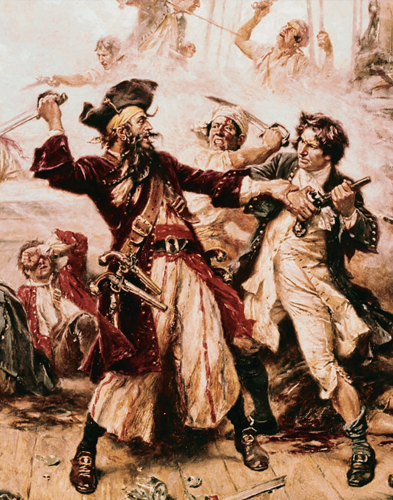Trivia

The Maniots, one of Greece’s most warlike peoples, descend directly from the Spartans of old. Since the dawn of modern times until the mid-19th-c., the Maniots have gained a reputation as pirates. They saw piracy as a legitimate means to preserve their sovereignty. Also, because Maniot land is not very fertile, people turned to piracy as a source of income. Although they prayed mostly on Ottomans, Maniot pirates would go after Christian ships on occasion.
Now that we live in a globalized world and imperial hegemony is a thing of the past, the emergence of new failed states has led to the increase and diversification of piracy throughout the world. Modern pirates rely on precise logistics, efficient support bases and highly profitable business models.
The International Maritime Bureau (IMB) 2011 Report states that piracy is on the rise, pirates tend to be heavily armed, and they grow bold and violent.
More than half of all pirate attacks were undertaken by Somali pirates, who’ve been expanding their territorial reach all over the Indic, traveling as far as Kenya, Tanzania, the Comoros and Seychelles.
Attacks in the Gulf of Guinea, off Nigeria, have been reported, which points to an ongoing threat to shipping lanes along the West Coast of Africa and especially the alternative Cape seaway. In the Far East, the straits of Singapore, Malaysia and Indonesia have also witnessed acts of piracy.
There’s no ‘optimistic scenario’ in sight. That would entail continuing (and viable) military solutions: not only the deployment of international vessels as a deterrent and a platform for rescue operations, but also political and military interventions to stabilize failed states wherever support bases would be placed, which would allow the resumption of traditional economic activities, such as subsistence fishing on territorial waters monitored by legitimate means of defense.
A pessimistic scenario is far more likely. The phenomenon of piracy may contaminate other regions and, in all likelihood, ethnic/religious support networks are already in place here and there. Africa, the Middle and the Far East are brimming with potential recruits to the cause of piracy, people who would have entered Europe as illegal migrants but are increasingly turned back.
Taking Somalia for a case study, international intelligence experts have started with the concept of opportunity cost to undertake a cost-benefit analysis of piracy, establishing a ‘Pirate Value Chain’ that includes all the relevant stakeholders.
This isn’t to say Somalia is unique in terms of piracy. If you take a look at the global market for piracy, you realize that piracy is bolstered by government bodies, financiers and sponsors, who may not always be easy to identify. Transportation companies also intervene as stakeholders – as is the case with carriers that dump toxic waste on territorial waters without sovereign defense, or international fishing fleets from Europe, Asia and America engaging in IUU (‘illegal, undeclared, unregulated’) activities.
No less important is the assessment of returns obtained by stakeholders whose business it is to mitigate the costs of piracy: insurers who must adjust their risk rates and the coverage they provide; private security firms that offer deterrence & rescue solutions; as well as manufacturers or providers of prevention/deterrence and security technologies.
No less important is the assessment of returns obtained by stakeholders whose business it is to mitigate the costs of piracy: insurers who must adjust their risk rates and the coverage they provide; private security firms that offer deterrence & rescue solutions; as well as manufacturers or providers of prevention/deterrence and security technologies.
‘Supply’ grows as maritime trade and transportation picks up and markets expand through access to new geographic areas; access to profitable opportunities for illegal fishing and toxic waste disposal is on the increase as operators are driven from international waters or those under national sovereignty, due to environmental reasons and the intent to preserve biodiversity. 'Demand,' therefore, is likely to increase as new pirates join the market, drawn by the prospect of new victims – so new attacks will come.
The pirate trade, which has proven lucrative so far, needs more and more skilled workers. Not only people with military and naval training but also agents in key strategic positions, such as international maritime trade markets, where they can access insider information on shipping lanes, commodity and freight costs; also financial experts who specialize in secure money-laundering processes in order to access legitimate financial markets and then reinvest the profits of piracy to finance additional operations like recruitment and training of new pirates, as well as purchasing weaponry and seagoing vessels.
However, this increasingly specialized labor will not remain available once the personal risks involved (death, maiming, disability, incarceration) outweigh the risk/opportunity cost inherent in not being a pirate.
However, this increasingly specialized labor will not remain available once the personal risks involved (death, maiming, disability, incarceration) outweigh the risk/opportunity cost inherent in not being a pirate.
In order to assess and mitigate the cost and risk in piracy, risk management models identifying the costs and benefits to all the stakeholders in the ‘Pirate Value Chain’ will let us define adequate and efficient corrective measures. Obviously, under the assumption that there are sovereign states willing and able to end this profitable offshore market run by transnational stakeholders, on both the 'supply' and 'demand' side of the equation.
The 'demand' side includes shippers whose boats sail under flags of convenience, crewed by multi-ethnic, multinational forces. They haul cargo whose ownership, provenance and destination are often undetermined, or they engage in profitable illegal, undeclared, unregulated fishing and even worse things, like the transportation and disposal of toxic waste.
By Pedro Castro Caldas, Risk Management Consultant
The 'demand' side includes shippers whose boats sail under flags of convenience, crewed by multi-ethnic, multinational forces. They haul cargo whose ownership, provenance and destination are often undetermined, or they engage in profitable illegal, undeclared, unregulated fishing and even worse things, like the transportation and disposal of toxic waste.
By Pedro Castro Caldas, Risk Management Consultant



